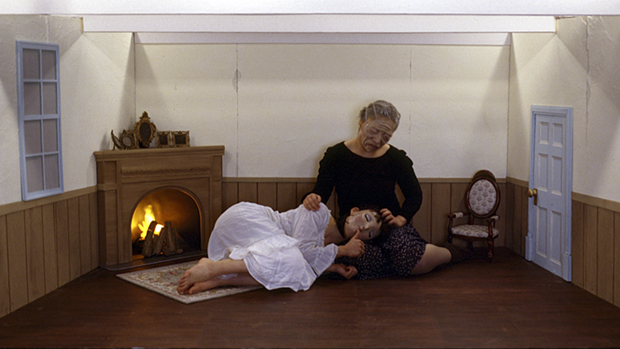"LULLABY" 2010, Video installation. 12 min.
I plan most gallery and museum visits ahead. But there are handful of places that I know of around town that I will visit on a whim, if I happen to be in the neighbourhood and have the time. Smaller galleries are often free, and don’t require a huge chunk of your time to get through. A few days ago, I dropped in at Rat Hole Gallery — a place I’ve only recently discovered, but enjoyed my first visit to.
And sometimes those unplanned visits are the best.
It isn’t as though I needed more proof that Miwa Yanagi is a genius, but now Rat Hole Gallery has quietly put on a solo exhibition involving a handful of her photographic works (less than a handful, really… more like a half-handful, but happily it was a half-handful that I had never seen), plus one brand-new, never-before-screened video work of Brobdingnagian proportions… or at least that describes the people in it.
Yanagi’s “Lullaby” opens with two women in masks, one old and one young, sitting in a room much too small for them. A fire crackles in the fireplace. A tiny chair sits next to the too-small door. And the grandmotherly figure sits with the younger girl sleeping in her lap as the older woman strokes her hair and quietly sings.
Until the tables turn, that is. Suddenly, the girl has the older woman in a headlock, and the two are grappling. It’s hilarious. It’s disturbing. It’s scarily realistic. And within moments, the girl has violently forced the old woman’s head into her lap, where she proceeds to take up the lullaby, stroking the old woman’s hair peacefully.
But then the reversal happens again. And again. And again. Until the two — now seeming more like two opposing forces than actual people — have destroyed the walls of the house, shattered the illusion of comfort, and taken up combative stances on what has become a bare, outdoor stage.
Thematically, there is nothing surprising here. Much of Yanagi’s latest work has played youth against age, almost exclusively in women. Her older women are never fragile victims, but the powerful hags of folklore. Nor are her girls any more innocent or powerless. In “My Grandmothers” she photographed young women as they imagined themselves in old age — and none imagined themselves frail or boring. And in “Fairy Tale,” she dressed small girls in the masks of old women, and put them in vaguely familiar fairy tale scenes.
Yanagi is working a familiar theme here; one that she’s adept, playful and insightful with. And she has no qualms about taking it to extremes. Part of what is so wonderful about “Lullaby” is that it goes beyond fairy tale imagery, and straight into archetype.
One of the most unsettling aspects of the battle is that the spoils are expressed in kindness — the ability to smile down upon the other and sing them to sleep. Can lullabies be sung only from a position of power? Kindness here seems to be the smiling beneficence of the victor; the sympathy of the strong. This is, after all, both a domestic struggle within the home, but also a personal struggle between age and youth, and the contempt that they have for one anther. And the entire situation is not a problem to be solved, so much as two sides of the same coin.
I might have raised an eyebrow if someone had told me that Yanagi was planning to move into video, but having seen it for myself. Well, I’m a believer.
Now sadly, the show ends on March 21. Yeah. That soon. So if you can get yourself there, do it. But if not, “Lullaby” will likely be wrestling its way into another exhibition before long.
-Owen Schaefer









